Have you ever hosted a warm summer evening only to realize your backyard disappears into darkness the moment guests arrive? If your outdoor space looks great by day but feels unusable or unsafe at night, you’re not alone. With the right lighting ideas landscape owners can extend entertaining hours, highlight favorite features, and add security — all without a professional electrician for many simple upgrades.
Why thoughtful landscape lighting matters
Good landscape lighting design does more than just illuminate a space. It boosts curb appeal, draws attention to plantings and architectural details, and creates zones for dining, cooking, and relaxing. Whether your goal is soft garden mood lighting, secure pathway illumination, or dramatic tree uplighting, planning is the first step to a successful DIY landscape lighting project.
Plan before you buy: a simple lighting design process
1. Walk the space at night
Turn off existing lights and use a flashlight to note problem areas: dark steps, corners, and long sightlines. Identify the focal points you want to highlight — a specimen tree, a water feature, or the façade of your home.
2. Create zones and assign light types
- Pathway lighting: soft, low-level fixtures for safety
- Accent lighting: spotlights and uplights for trees and sculptures
- Task lighting: brighter lights near grills, outdoor kitchens, and work areas
- Ambient lighting: string lights, lanterns, or bollards for mood
3. Choose power: solar, low-voltage, or line-voltage
Solar-powered landscape lights are quick and inexpensive for borders and pathways, but performance varies. Low-voltage (12V) systems balance brightness and safety and are ideal for DIY installations. Line-voltage systems (120V) are powerful but usually warrant a licensed electrician.
DIY lighting ideas landscape homeowners can tackle this weekend
Below are several practical projects with step-by-step instructions that range from beginner-friendly to intermediate. Each includes cost-saving tips and design notes.
Project A — Install solar pathway lights (beginner)
- Plan spacing: place lights about 6–8 feet apart for gentle continuity (closer for narrower paths).
- Mark positions with spray paint or flags.
- Push stakes into the ground or use a small trowel to clear a shallow hole.
- Assemble and insert lights; ensure panels are aimed for max sun exposure.
- Run them for a few nights to check brightness — adjust spacing if needed.
Tip: Choose warm-white LEDs (2700K–3000K) for a welcoming glow and look for rechargeable battery models to improve reliability.
Project B — Low-voltage accent lighting with spotlights (intermediate)
- Map your layout and calculate wattage. Add a 20–25% buffer for future additions.
- Install a 12V transformer near a GFCI outlet and mount it in a weatherproof box.
- Lay out 12-gauge or 14-gauge landscape wire from the transformer to each fixture, hiding it under mulch or in a shallow trench.
- Use wire connectors or direct-screw terminals on fixtures. Keep connections off the ground where possible.
- Aim and secure fixtures; use barn doors, snoots, or deflectors to control spill light.
- Test the system, set timers or smart controls, and adjust angles for the desired effect.
Tool list: voltage tester, wire cutters, landscape staples, shovel, and a ladder. Safety note: turn off power at the outlet before wiring the transformer.
Project C — Create a cozy patio with string and lantern lighting (easy)
- Choose durable, outdoor-rated string lights (LED) with weatherproof plugs.
- Anchor hooks into posts, eaves, or sturdy trees using rated eye screws.
- Drape lights in gentle sag lines for a cafe-style effect or run in straight lines for a modern look.
- Add battery lanterns or table lamps for local task lighting without more wiring.
Design idea: Pair string lights with dimmable smart plugs to control brightness and schedules.
Design techniques to make your landscape feel expensive
Use these pro-level techniques to elevate ordinary fixtures:
- Uplighting: place fixtures low to highlight tree trunks and canopy structure.
- Moonlighting: mount a light high in a tree aimed down to mimic moonbeams over seating areas.
- Silhouetting: position lights in front of a subject so it appears dark against a lit backdrop.
- Wall grazing: place strip lights or narrow beam lights close to textured walls to reveal depth.
Budget-friendly tips and maintenance
Start with a layered approach: prioritize safety lights (steps, paths), then add accents. To save money, buy telescoping stakes and replace bulbs with LEDs for efficiency. Routine maintenance — cleaning lenses, checking batteries, and trimming foliage — keeps performance high.
Smart controls and energy efficiency
Integrate timers, motion sensors, or smart plugs to automate lights and save energy. Consider solar-powered options for border lighting and LED fixtures for lower wattage without sacrificing brightness. Smart landscape lighting systems can be expanded over time and controlled from your phone for convenience.
Safety and local rules
Check local codes for fixtures near the street and any restrictions on brightness or colors. For buried wiring, call your local utility marking service before digging. When in doubt about high-voltage work, hire a licensed electrician.
Frequently Asked Questions
1. What are the best lighting ideas landscape owners can start with on a small budget?
Begin with solar pathway lights and string lights. They require no wiring, are easy to install, and immediately improve usability. Prioritize safety areas like steps and pathways first.
2. How far apart should I place pathway lights?
For general guidance, place pathway lights every 6–10 feet. Narrow or winding paths may need closer spacing for even illumination. Adjust based on fixture lumen output and desired brightness.
3. Is it better to use solar or low-voltage landscape lighting?
Solar is ideal for quick, low-cost installs and low-maintenance borders. Low-voltage systems provide greater reliability, better light control, and compatibility with a wider range of fixtures, making them the preferred choice for accent and task lighting.
Conclusion: Start improving your yard tonight
Whether you want simple solar markers along your walkway or a full low-voltage accent and uplighting scheme, these lighting ideas landscape projects will help you create a safer, more attractive outdoor space. Start small: map your space, pick the most critical zone, and try one of the weekend DIY projects listed above. Ready for more home improvements? Check out our pages on DIY projects, kitchen upgrades, and home design ideas for additional inspiration.
Want help choosing fixtures or planning placement? Leave a comment or sign up for our newsletter to get step-by-step project checklists and product recommendations.



